Genetics is the science of heredity. It includes the study of genes and the inheritance of variation and traits of living organisms. It is an important part of biology and gives the basic rules on which evolution acts.
The fact that living things inherit traits from their parents is known for a long time. The modern science of genetics seeks to understand the process of inheritance.
Some of the human diseases are related to genetics. The unit of genetic structure is deoxyribonucleic acid (DNA). DNA is organized in the form of genes. Each gene is responsible for one or a set of functions. Some human diseases are related to a single gene. Some other diseases of genetic origin are related to more than one gene. In a group of persons having the same genetic disease, a similar pattern of genes is observed. In such cases, they may respond to a drug in a similar fashion. This observation has led to the development of personalized medicine. The study of genetics is important for personalized medicine. The principles of personalized medicines can help in reducing adverse reactions to a set of persons with genetic similarity
Genetics is the study of genes. It involves knowledge about genes and their functioning. Genes are located inside the nucleus and their sequence carries information. This information determines how living organisms inherit various features which are called phenotypic traits. Genetics identifies which features are inherited and explains how these features pass from one generation to another. In addition to inheritance, it studies how genes are turned on and off to control which substances are made in a cell-gene expression; and how a cell divides mitosis and meiosis.
Some phenotypic traits like the color of the eye are clearly visible. Other phenotypic traits like variation in an enzyme may not be easily visible. Traits determined by genes can be modified by environment e.g. height of a person is determined both by genetics and nutrition.
Table of Contents
Chromosomes
A chromosome is a DNA molecule with part or all of the genetic materials (genome) of an organism. Chromosomes are normally visible under a light microscope only when the cell is undergoing the metaphase of cell division. Before cell division, every chromosome is copied once during the S phase. The copy is joined to the original by a centromere resulting in an X-shaped structure. (Fig. 1.1).
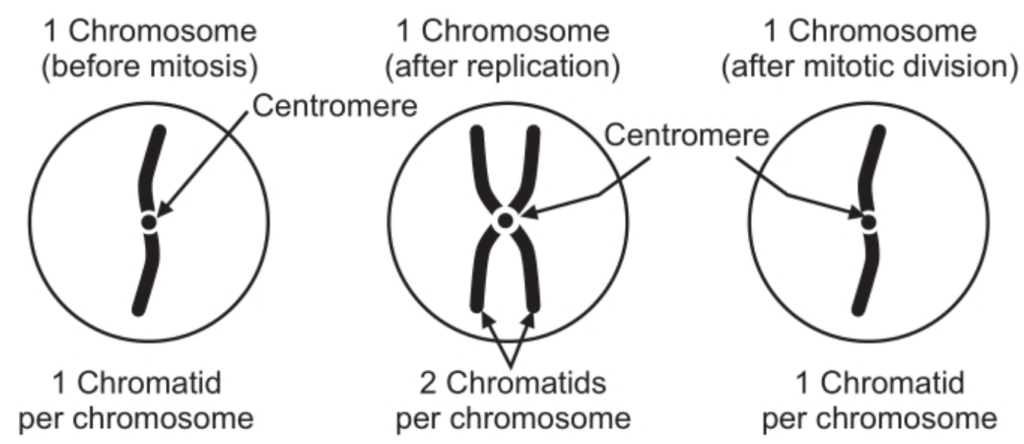
The original chromosome and the copy are now called sister chromatids, During metaphase, when a chromosome is in its most condensed state, the X-shaped structure is called a metaphase chromosome. In this highly condensed form chromosomes are identified under the light microscope.
Compaction of the duplicated chromosomes during cell division (mitosis/meiosis) results either in a four-arm structure (see figure). The shape of a chromosome depends on the location of the centromere. If the chromatin is located in the center the two arms are equal. If the centromere is located near one of the arms the structure is asymmetrical as shown in Fig. 1.1. Chromosomal recombination during meiosis and subsequent sexual reproduction plays a significant role in genetic diversity. If these structures are manipulated incorrectly, the cell may undergo mitotic catastrophe and die; or it may unexpectedly evade apoptosis leading to the progression of cancer.
Nuclear chromosomes are packed by proteins into a condensed structure called chromatin. This allows very long DNA molecules to fit into the tiny cell nucleus. The structure of chromosomes and chromatin varies through the cell cycle. They are even more condensed than chromatin and are an essential unit for cellular division. They must be replicated, divided, and passed successfully to their daughter cells to ensure that the genetic diversity and survival of the progeny are maintained. They may exist as either duplicated or unduplicated. Unduplicated chromosomes are single double helixes, while duplicated chromosomes contain two identical copies, called sister chromatids, and are joined by a centromere.
In the early stages of mitosis or meiosis, the chromatin double helix becomes more and more condensed. During this stage transcription stops and genetic material becomes a compact transportable form. The compact form makes individual chromosomes visible. Mitotic metaphase chromosomes are best described by a linearly organized, longitudinally compressed array of consecutive chromatin loops.
During mitosis, microtubules grow from centrosomes located at opposite ends of the cell and attach to the centromere at specialized structures called kinetochores, one of which is present on each sister chromatid. A special DNA base sequence in the region of kinetochores provides longer standing attachment in this region. The microtubules then pull the chromatids apart towards the centrosomes so that each daughter cell inherits one set of chromatids. Once the cells have divided, the chromatids are uncoiled and DNA can again be transcribed.
Human Chromosomes
Chromosomes in human beings can be divided into two types: autosomes and allosomes. The autosomes contain genetic hereditary information related to body characteristics except for sex. Allosomes are sex chromosomes. Certain genetic traits are linked to a person’s sex and are passed through the sex chromosome. All chromosomes act in the same way during cell division. Human cells have 22 pairs of autosomes and one pair of allosomes. The total makes 23 pairs or 46 chromosomes. The following table gives the number of genes and % of the basis for each gene.
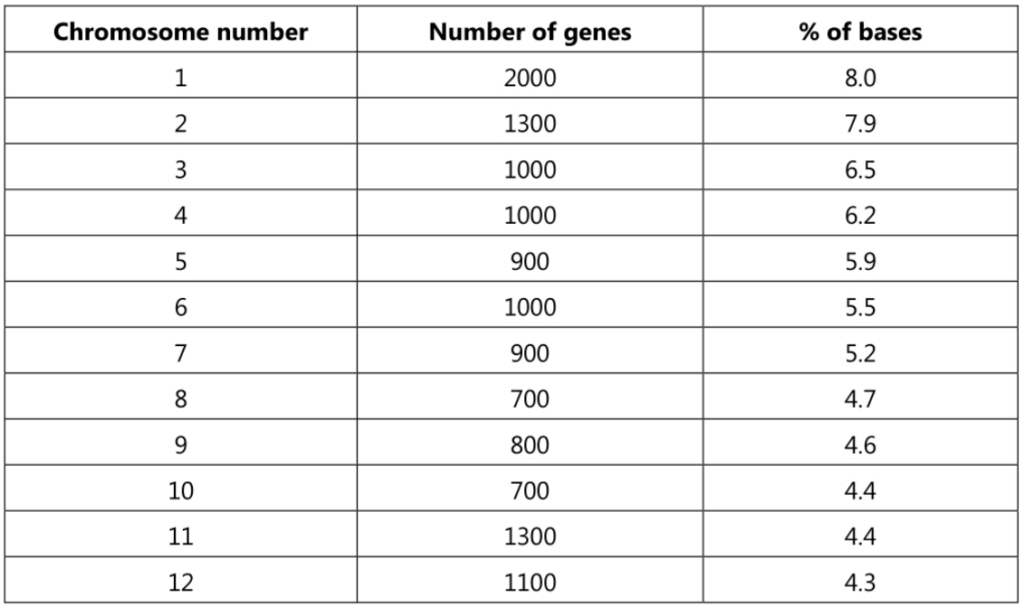

It is to be noted that for the same number of genes, total base pairs may vary because some of the sequences are silent. Hence, figures in column number 2 do not match exactly with the % basis in column number 3.
GENES AND DNA
DNA
The molecular basis for genetics is deoxyribonucleic acid (DNA). It consists of a chain made from four types of nucleotide subunits, each composed of a five-carbon sugar, called 2-deoxyribose; a phosphate group, and one of four bases: Adenine (A), Cytosine (C). Guanine (G) and Thymine (T).
Two chains of DNA twist around each other to form a DNA double helix with the phosphate-sugar backbone spiraling around the outside and the bases pointing inwards. In the inner part of the helix adenine base pairs with thymine while guanine base pairs with cytosine. The specificity of base pairing occurs because A pairs with T with two hydrogen bonds while C pairs with G with three hydrogen bonds. Thus, two strands in a double helix are complementary, with their sequence of bases matching such that As of one strand pair with Ts of complementary strand and Cs of one strand pair with Gs of complementary strand.
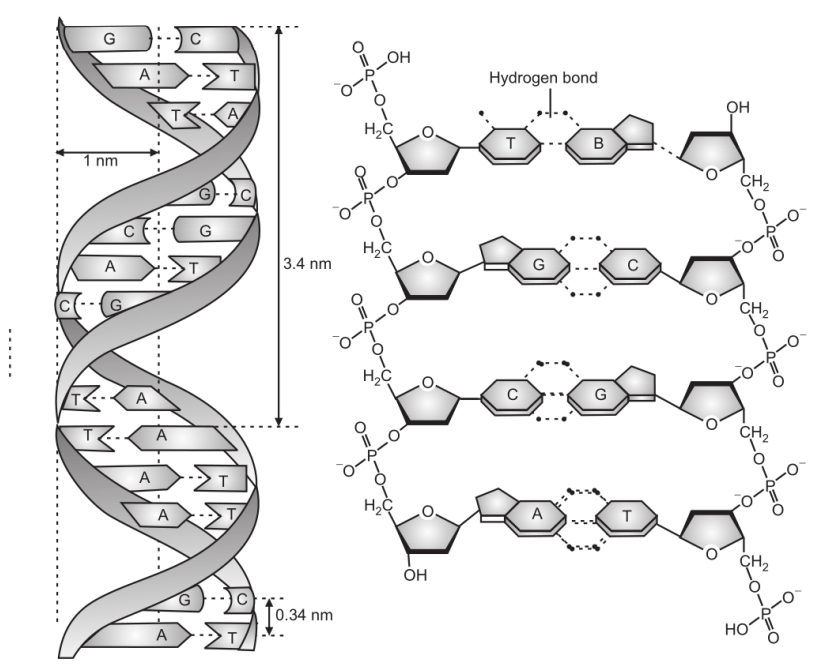
Due to the chemical composition of the pentose residues of the bases, DNA strands have directionality. One end of a DNA polymer contains an exposed hydroxyl group on the deoxyribose; this is known as the 3′ end of the molecule. The other end contains an exposed phosphate group; this is the 5′ end. The two strands of a double helix run in opposite directions. Nucleic acid synthesis, including DNA replication and transcription, occurs in the 5′ →→ 3′ direction because new nucleotides are added via a dehydration reaction that uses the exposed 3′ hydroxyl as a nucleophile.
The expression of genes encoded in DNA begins by transcribing the gene into RNA, the second type of nucleic acid which is similar to DNA with the only difference that sugar content in RNA is ribose, unlike deoxyribose in DNA. RNA also contains the base uracil in place of thymine. RNA molecules are less stable than DNA and are typically single-stranded. There are two types of RNA: t RNA and m RNA. t RNA is a transfer RNA that has a three-nucleotide sequence called codon at its one end. At another end, t RNA carries one amino acid. Every amino acid has a different t RNA for the purpose of translocation.
Gene
A gene is a locus or region of DNA which is made up of nucleotides and is the molecular unit of heredity. The transmission of genes to an organism’s offspring is the basis of the inheritance of phenotypic traits. These genes make up different DNA sequences called genotypes. Genotypes along with environmental and developmental factors determine what the phenotypes will be. A set of genes together is called polygenes. Many biological traits are under the influence of polygenes and gene-environmental interactions. Some genetic traits like the color of the eye are instantly visible. Some other traits like blood groups may not be instantly visible.
Genes can acquire mutations in their sequence, leading to different variants known as alleles. These alleles encode slightly different versions of a protein, which cause different phenotypical traits. Usage of the term “having a gene” typically refers to containing a different allele of the same gene. Genes evolve due to natural selection or struggle for existence leading to the survival of the fittest amongst alleles.
The concept of a gene continues to be refined as new phenomena are discovered. Some viruses store their genome in RNA instead of DNA and some gene products are functional non-coding RNAs. Therefore a broad, modern working definition of a gene is any discrete locus of heritable, genomic sequence which affects an organism’s traits by being expressed as a functional product or by regulation of gene expression.
Structure of a Gene
The structure of a gene consists of many elements of which the actual protein coding sequence is often only a small part. These include DNA regions that are not transcribed as well as untranslated regions of the RNA.
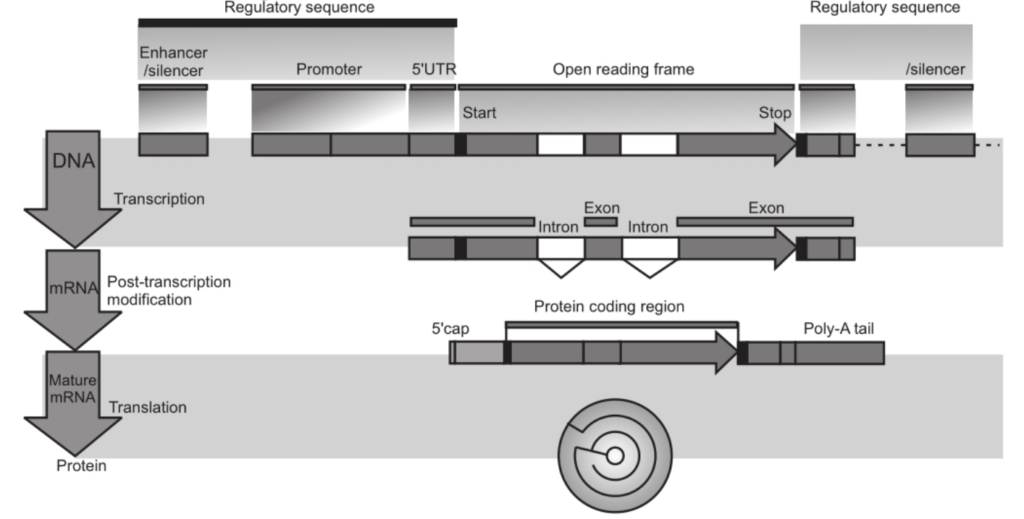
All genes contain a regulatory sequence that is required for their expression. In order to be expressed, genes require a promoter sequence. The promoter is recognized and bound by transcription factors and RNA polymerase to initiate transcription. A gene can have more than one promoter resulting in m RNAs which differ in how far they extend in 5′ end. Promoter regions have a consensus sequence, however, highly transcribed genes have strong promoter sequences; while others have weak promoters which bind poorly and initiate transcription less frequently.
In addition, genes can have regulatory regions upstream or downstream to the open reading frame. These act by binding to transcription factors which then cause the DNA to loop so that the regulatory sequence becomes close to the RNA polymerase binding site. There are enhancer or silencer regions in a gene. Enhancers increase transcription by binding an activator protein which then helps to recruit the RNA polymerase to the promoter. Conversely, silencers bind repressor proteins and make the DNA less available for RNA polymerase.
The transcribed pre-cum RNA contains untranslated regions at both ends which contain a ribosome binding site, terminator and start and stop codons. In addition, open reading frames contain untranslated introns which are removed before exons are translated. The sequences at the end of introns dictate the splice sites to generate the final mature m RNA which encodes the protein or RNA product.
Many genes are organized into operons, with multiple coding sequences which are transcribed as a unit. The genes in an operon are transcribed as a continuous m RNA: referred to as polycistronic m RNA. The term cistron is equivalent to a gene. The transcription of an operon’s m RNA is often controlled by a repressor which can occur in an active or inactive state depending on the presence of certain metabolites. When active, the repressor binds to a DNA sequence at the beginning of the operon, called the operator region, and represses transcription of the operon. When the repressor is inactive, the transcription of the operon can occur. The products of operon genes typically have related functions and are involved in the same regulatory network.
Functions of Genes:
Gene Expression:
In all organisms, two steps are required to read the information encoded in a gene’s DNA and produce the protein which it specifies
- First, the gene’s DNA is transcribed to m RNA.
- Second, that m RNA is translated to protein.
RNA coding genes must still go through the first step but are not translated into protein. The process of producing a biologically functional molecule of either RNA or protein is called gene expression, and the resulting molecule is called a gene product.
Genetic Code:
The nucleotide sequence of a gene’s DNA specifies the amino acid sequence of a protein through the genetic code. Sets of three nucleotides, called codons, each corresponds to a specific amino acid.
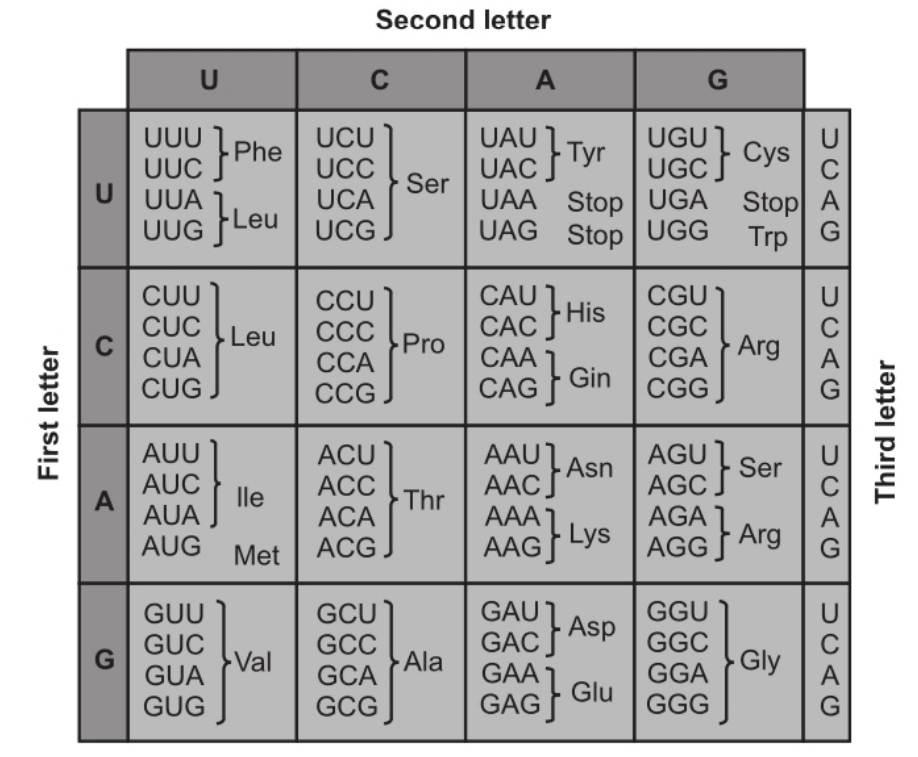
In addition, a start codon and three stop codons indicate the beginning and end of the protein-coding region. For four nucleotides there are 4³= 64 possible codons. There are 20 standard amino acids. Thus, multiple codons can specify the same amino acid. The correspondence between codons and amino acids is universal amongst all known living organisms.
Transcription:
Transcription produces a single-stranded m RNA, whose nucleotide sequence is complementary to the DNA from which it is transcribed. The m RNA acts as an intermediate between a gene and the final protein. The transcription is performed by an enzyme called RNA polymerase, which reads the template strands in the 3’5′ direction and synthesizes the RNA from 5’3′. To initiate transcription, the polymerase first recognizes and binds to the promoter region of the gene. Thus, a major mechanism of gene regulation is blocking or sequestering the promoter region, either by tight binding to repressor genes or by organizing the DNA so that the promoter region is not accessible.
Translation:
The translation is the process by which a mature RNA molecule is used as a template for synthesizing a new protein. The process is carried out by ribosomes, large complexes of RNA and protein responsible for carrying out chemical reactions to add new amino acids to a growing polypeptide chain by the formation of peptide bonds. The genetic code is read as three nucleotides at a time, in units called codons via interactions with t RNA Each t RNA has three unpaired bases which are known as anticodon and are complementary to the codon on m RNA. The t RNA is covalently attached to the amino acid specified by the complementary codon. When the t RNA binds to its complementary codon in an m RNA strand, the ribosome attaches its amino acid cargo to the new polypeptide chain, synthesized from amino-terminus to carboxyl-terminal. During and after synthesis, most new proteins must hold to their active three-dimensional structure before they can carry out their cellular functions.
Regulation:
Genes are regulated so that they are expressed only when the protein is needed. because expression draws on limited resources. A cell regulates its gene expression based on the external environment, internal environment, and its specific role in a multicellular organism. The external environment includes available nutrients, temperature, and other stresses. The internal environment includes the cell division cycle, metabolism, infection status, etc. A specific role includes whether the cell is part of the bone, skeletal muscle, or smooth muscle, etc. gene expression can be regulated at any step: from transcriptional initiation to RNA processing or to post-translational modification of the protein.
RNA Genes:
A typical protein-coding gene is first copied into RNA as an intermediate during the manufacture of a protein. In other cases, the RNA molecules are the actual functional products, as in the synthesis of ribosomal RNA and t RNA. Some RNAs known as ribozymes are capable of enzymatic function, and micro RNA has a regulatory role. The DNA sequences from which such RNAs are transcribed are called non-coding RNA genes.
Some viruses store their entire genomes in the form of RNA and do not contain DNA at all.
Genome:
The genome is the total genetic material of an organism and includes both genes and non-coding sequences.
The size of the genome and the number of genes it encodes varies widely between organisms Number of base pairs of DNA in the human genome is known since the 1960s Sequencing of genes in the human genome project indicated that the total number of protein-coding genes is only about 20,000 with 13 genes encoded on the mitochondrial genome. Of the human genome, only 1-2% consist of protein-coding genes, with the remainder being non-coding DNA such as introns, retrotransposons, and non-coding RNAs.
Pattern of Inheritance
Organisms inherit their genes from their parents. There are two copies of each chromosome because they inherit one complete set from each parent.
Mendelian Inheritance:
It involves two terms: phenotype and genotype. Phenotypes are observable physical and/or behavioral characteristics e.g. color of the eye. Genotypes are a particular set of genes. Each gene specifies a particular trait with a different sequence of the gene, called alleles, giving rise to different phenotypes. Thus, one genotype can lead to more phenotypes, probably because of environmental alterations.
Alleles at a locus may be dominant or recessive. Dominant alleles give rise to their corresponding phenotypes when paired with any other allele for the same trait. In the case of recessive alleles, they give rise to the corresponding phenotype only when paired with another copy of the same allele. If you know the genotypes of the organisms, you can determine which alleles are dominant and which are recessive. Mendel’s work demonstrated that alleles assort independently in the production of gametes or germ cells, ensuring variation in the next generation. Mendelian inheritance continues to be a good model for many traits determined by single genes. Genetic disorders linked to a single gene follow Mendelian inheritance. It does not include the physical process of DNA replication and cell division. Molecular details of genetics were not known during Mendelian inheritance.
Molecular inheritance:
The duplication and transmission of genetic material from one generation of cells to the next is the basis of molecular inheritance. It is the link between classical and molecular genetics. Organisms inherit the characteristics of their parents because the cells of the offspring contain copies of the genes of their parent’s cells. During cell division the first. the stage is meiosis, wherein the cells get one copy of each gene. The gametes produced by the female are eggs/ova and those produced by males are sperms. Two gametes fuse to form a diploid fertilized egg. a single cell having two sets of genes, one each from the mother and the father.
During meiosis, an event called genetics recombination or crossing over occurs, in which a length of DNA on one chromatid is swapped with a length of DNA on the corresponding homologous non-sister chromatid. This can result in the re-assortment of otherwise linked alleles. The Mendelian principle of independent assortment asserts that each of a parent’s two genes for each trait will sort independently into gametes; which allele an organism inherits for one trait is unrelated to which allele it inherits for another trait. This is true for genes that do not reside on the same chromosome or are located very far from one another on the same chromosome. The closer two genes lie on the same chromosome, the more closely they will be associated with gametes and the more often they will appear together. Genes that are very close are never separated because it is extremely unlikely that a cross-over point will occur between them. This is known as genetics linkage.
Mutation:
DNA replication is extremely accurate; however, errors can occur. The errors are called mutations. Small mutations can be caused by DNA replication. It can take different forms In point mutations a single base is altered. In frameshift mutations, a single base is inserted or deleted. Either of these mutations can change the gene either as a missense or nonsense. In the case of missense, there is a change in codon to encode a different amino acid. In the case of nonsense, there is a premature stop codon leading to incomplete transcription/translation. Large mutations can be caused by errors in recombination to cause chromosomal abnormalities such as duplication, deletion, rearrangement, or inversion of large sections of a chromosome. In addition, DNA repair mechanisms can introduce mutational errors while repairing physical damage to the molecule. The repair, even with mutation, is more important to survival than restoring an exact copy, e.g. repairing of double-strand breaks.
When multiple different alleles for a gene are present in a species’ population, it is called polymorphic. Most different alleles are functionally equivalent, however, some alleles can give rise to different phenotypes. A gene’s most common allele is termed as wild type, and rare alleles are called mutants. Genetics variation in the relative frequency of different alleles in a population is due to both natural selection as well as genetic drift. The wild types are not necessarily the ancestors of less common alleles, nor are they fitter than the modified alleles.
Mutations can be of different types. Those having no effect on an organism’s phenotype are called silent mutations. Some mutations do not change the amino acid sequence because multiple codons encode the same amino acid. They are called synonymous mutations. Some mutations can be silent, but the changed amino acid sequence of the protein still preserves the functions of the protein. They are called conservative mutations. However many mutations are deleterious or even lethal; such mutations are removed from populations by natural selection. Genetic disorders are the result of deleterious mutations and can be due to spontaneous mutation in the affected individual, or can be inherited. Over and above this, a small fraction of mutations is beneficial, leading to better fitness, and are extremely important for evolution.
Sequence Homology
Genes with a most recent common ancestor, and thus a shared evolutionary ancestry are called homologs. These genes can appear from gene duplication within an organism’s genome, where they are known as paralogous genes. Alternatively, they are the result of diversions of the genes after a speciation event where they are known as orthologous genes; such genes often perform the same or similar functions in the related organism.
The relationship between genes can be measured by comparing the sequence alignment of their DNA. The degree of sequence similarity between homologous genes is called the conserved sequence.
Origin of New Genes
The most common source of new genes is gene duplication, which creates copy number variation of an existing gene in the genome. The resulting genes may then diverge in sequence and in function. Sets of genes formed in this manner are called gene families. Gene duplications and losses within a family are common and represent a major source of biological diversity. Sometimes gene duplication may result in a non-functional copy of a gene, or a functional copy may have mutations leading to loss of function. Such non-functional genes are called pseudogenes.
Some sequences show no similarity to existing genes and are less common than gene duplicates. They are called orphan genes. Horizontal gene transfer refers to the transfer of genetic material through a mechanism other than reproduction. This mechanism is a common source of new genes. Sometimes they contribute more to genetic variation than gene duplication. It is a common means of spreading antibiotic resistance, virulence, and adaptive metabolic functions.
Make sure you also check our other amazing Article on: Blood pressure
